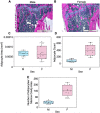The Cortical Bone Metabolome of C57BL/6J Mice Is Sexually Dimorphic
- PMID: 35866150
- PMCID: PMC9289981
- DOI: 10.1002/jbm4.10654
The Cortical Bone Metabolome of C57BL/6J Mice Is Sexually Dimorphic
Abstract
Cortical bone quality, which is sexually dimorphic, depends on bone turnover and therefore on the activities of remodeling bone cells. However, sex differences in cortical bone metabolism are not yet defined. Adding to the uncertainty about cortical bone metabolism, the metabolomes of whole bone, isolated cortical bone without marrow, and bone marrow have not been compared. We hypothesized that the metabolome of isolated cortical bone would be distinct from that of bone marrow and would reveal sex differences. Metabolite profiles from liquid chromatography-mass spectrometry (LC-MS) of whole bone, isolated cortical bone, and bone marrow were generated from humeri from 20-week-old female C57Bl/6J mice. The cortical bone metabolomes were then compared for 20-week-old female and male C57Bl/6J mice. Femurs from male and female mice were evaluated for flexural material properties and were then categorized into bone strength groups. The metabolome of isolated cortical bone was distinct from both whole bone and bone marrow. We also found sex differences in the isolated cortical bone metabolome. Based on metabolite pathway analysis, females had higher lipid metabolism, and males had higher amino acid metabolism. High-strength bones, regardless of sex, had greater tryptophan and purine metabolism. For males, high-strength bones had upregulated nucleotide metabolism, whereas lower-strength bones had greater pentose phosphate pathway metabolism. Because the higher-strength groups (females compared with males, high-strength males compared with lower-strength males) had higher serum type I collagen cross-linked C-telopeptide (CTX1)/procollagen type 1 N propeptide (P1NP), we estimate that the metabolomic signature of bone strength in our study at least partially reflects differences in bone turnover. These data provide novel insight into bone bioenergetics and the sexual dimorphic nature of bone material properties in C57Bl/6 mice. © 2022 The Authors. JBMR Plus published by Wiley Periodicals LLC on behalf of American Society for Bone and Mineral Research.
Keywords: BONE QUALITY; METABOLISM; METABOLOMICS; SEX DIFFERENCES.
© 2022 The Authors. JBMR Plus published by Wiley Periodicals LLC on behalf of American Society for Bone and Mineral Research.
Conflict of interest statement
The authors have no conflicts of interest to disclose. Dr. June owns stock in Beartooth Biotech which was not involved in this study.
Figures






Similar articles
-
Germ-Free C57BL/6 Mice Have Increased Bone Mass and Altered Matrix Properties but Not Decreased Bone Fracture Resistance.J Bone Miner Res. 2023 Aug;38(8):1154-1174. doi: 10.1002/jbmr.4835. Epub 2023 Jun 21. J Bone Miner Res. 2023. PMID: 37221143 Free PMC article.
-
Adenine-induced kidney disease alters the cortical bone metabolome of C57BL/6J mice in a manner that depends on sex.bioRxiv [Preprint]. 2025 Jun 3:2025.06.02.657438. doi: 10.1101/2025.06.02.657438. bioRxiv. 2025. PMID: 40502128 Free PMC article. Preprint.
-
Abaloparatide Has the Same Catabolic Effects on Bones of Mice When Infused as PTH (1-34).JBMR Plus. 2023 Jan 5;7(2):e10710. doi: 10.1002/jbm4.10710. eCollection 2023 Feb. JBMR Plus. 2023. PMID: 36751417 Free PMC article.
-
Age and Sex Differences in Load-Induced Tibial Cortical Bone Surface Strain Maps.JBMR Plus. 2021 Feb 16;5(3):e10467. doi: 10.1002/jbm4.10467. eCollection 2021 Mar. JBMR Plus. 2021. PMID: 33778328 Free PMC article.
-
Metabolomic Associations with Serum Bone Turnover Markers.Nutrients. 2020 Oct 16;12(10):3161. doi: 10.3390/nu12103161. Nutrients. 2020. PMID: 33081124 Free PMC article.
Cited by
-
Rapamycin does not alter bone microarchitecture or material properties quality in young-adult and aged female C57BL/6 mice.JBMR Plus. 2024 Jan 10;8(2):ziae001. doi: 10.1093/jbmrpl/ziae001. eCollection 2024 Feb. JBMR Plus. 2024. PMID: 38505525 Free PMC article.
-
The Role of Bone Cell Energetics in Altering Bone Quality and Strength in Health and Disease.Curr Osteoporos Rep. 2023 Feb;21(1):1-10. doi: 10.1007/s11914-022-00763-6. Epub 2022 Nov 26. Curr Osteoporos Rep. 2023. PMID: 36435911 Review.
-
Comparative Impact of Organic Grass-Fed and Conventional Cattle-Feeding Systems on Beef and Human Postprandial Metabolomics-A Randomized Clinical Trial.Metabolites. 2024 Oct 3;14(10):533. doi: 10.3390/metabo14100533. Metabolites. 2024. PMID: 39452914 Free PMC article.
-
Bioenergetic programs of cancellous and cortical bone are distinct and differ with age and mechanical loading.Sci Rep. 2025 May 31;15(1):19134. doi: 10.1038/s41598-025-02141-5. Sci Rep. 2025. PMID: 40450018 Free PMC article.
-
Metabolomic Profiles and Pathways in Osteoarthritic Human Cartilage: A Comparative Analysis with Healthy Cartilage.bioRxiv [Preprint]. 2024 Jan 25:2024.01.25.577269. doi: 10.1101/2024.01.25.577269. bioRxiv. 2024. Update in: Metabolites. 2024 Mar 25;14(4):183. doi: 10.3390/metabo14040183. PMID: 38328065 Free PMC article. Updated. Preprint.
References
-
- Glatt V, Canalis E, Stadmeyer L, Bouxsein ML. Age‐related changes in trabecular architecture differ in female and male C57BL/6J mice. J Bone Miner Res. 2007;22(8):1197‐1207. - PubMed
Grants and funding
LinkOut - more resources
Full Text Sources
